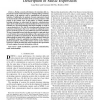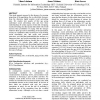70 search results - page 4 / 14 » Using movement and intentions to understand simple events |
TASLP
2008
13 years 7 months ago
2008
Abstract--During a music performance, the musician adds expressiveness to the musical message by changing timing, dynamics, and timbre of the musical events to communicate an expre...
BCSHCI
2009
13 years 8 months ago
2009
This study suggests reasons for the absence of a growing proportion of the population, the so-called baby boomers, from the otherwise highly popular social networking sites. We ex...
ARVLSI
1999
IEEE
13 years 11 months ago
1999
IEEE
The ability of animals to select a limited region of sensory space for scrutiny is an important factor in dealing with cluttered or complex sensory environments. Such an attention...
ISTCS
1992
Springer
13 years 11 months ago
1992
Springer
Concurrent Time-stamp Systems (ctss) allow processes to temporally order concurrent events in an asynchronous shared memorysystem, a powerful tool for concurrency control, serving...
SIGOPSE
1998
ACM
13 years 11 months ago
1998
ACM
with this, the thread abstraction was introduced. While threads are handling events, or awaiting specific events, unrelated events can be handled by other threads. Unfortunately, ...


